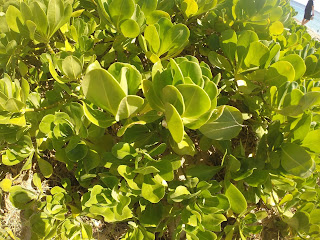Major differences:
There weren't as many big differences as I was expecting. Naupaka, koa haole, and a few birds I saw were at each site. The variety of species tended to change from beach to beach. For example, Ka'ena and Sandy were where I saw the most birds. I saw many native and endemic species at Ka'ena Point. This makes sense since the location is primarily a reserve. However, there were still quite a few introduced/invasive species. The other beaches were more recreational, so people weren't there to experience the coastal habitat, so many introduced species are allowed to roam around or grow, such as pigeons and koa haole.
The environment itself changed from beach to beach. Ka'ena Point and Yokohama are both dry, hot places. Waikiki and Sandy beach are somewhat dry, but no as much as Ka'ena or Yokohama. Makapuu was the most lush environment out of all the beaches I visited. This was most apparent when comparing the naupaka that grew at each beach. The Naupaka at Makapuu and Waikiki were very green, but I have a feeling that the naupaka at Waikiki get watered.
Similarities:
There were several species that I found at all the beaches or at several of them. Naupaka, koa haole, pigeons, and red-crested cardinals were the most common. Individuals from common species found around the island may be found on all of these beaches, but I cannot say for sure since I did not find them myself.
Naupaka at Ka'ena Point
Naupaka at Waikiki
Naupaka at Sandy beach
Naupaka at Yokohama
Naupaka at Makapuu
What about niches?
I found that these beach habitats were primarily occupied by low-lying shrubs and very few trees. Most of the beaches also had hilly/mountain terrain adjacent to the beach area, so there weren't many wetland-type species. Many of the plants, as far as I could tell, were succulent or adapted to dryness in some way. For animals, I saw that the representative bird species were ground-dwelling species, with a couple exceptions. Birds such as pigeons or the cattle egret that are most often found walking on the ground rather than perched on branches/fences/etc. I didn't see too much else in terms of animals, but the monk seals from Ka'ena are an example of a mammal that fits into the coastal ecosystem as a foraging predator.
Acknowledgements:
I wanted to give a quick shout-out to the people that drove me around to each of these beaches: Calder Atta, Kelly-Rose Lariosa, and Dr. Brenden Holland!




